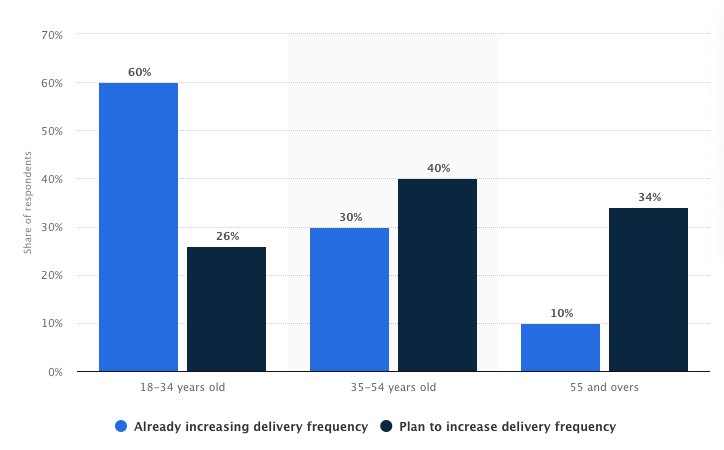How To Use Technology For Improving Food Delivery App
June 3rd, 2020
Food delivery is a crucial industry in the era of COVID-19, as people are being forced to #stayhome, reduce personal contacts in offices, markets, shops, and restaurants. And each delivery service all around the globe wants to make its delivery apps even more user-friendly, responsive, and modern. As claimed Allied Market Research (the food delivery market study), the industry of delivery mobile apps will reach $16.6B in 2023. For comparison in 2017 food delivery industry research revealed a value of about $3.7B.

Statistic of food delivery services due to the COVID-19 in Great Britain (March 2020)
Food Delivery Marketplace Models
In contrast to a restaurant take away services food delivery model gives full coordination support. Food delivery platforms are an extraordinary resource for new businesses, little eateries, and cafes, and other small places in the food business. As new contestants frequently need more assets to build up their own delivery, they go to organizations offering such types of assistance for an expense.
With food delivery services restaurants no longer need to stress over delivery the board – no staff, no transport, no managing cost, etc.
Request and delivery platform work this way:
- Clients submit a request, payment gets approved
- The app organizes delivery by giving their own delivery person
- At the point when the request is prepared, the restaurant informs a delivery person
- The delivery person gets the food and delivers it to the customer
- The app charges money after the order is completed
These services drive up the price from restaurants about 20%. What’s more, clients the same way pay a delivery cost (fixed or relying upon the separation).
The most famous examples of these platforms are:

How to Monetize Delivery App
Here we’re describing food delivery applications, the way to proceed requests, and transportation models. So how about we discover how these services get money.
UberEats delivery cost now relies upon distance in miles (before it was fixed price $4.99). In contrast, Glovo uses an established fee and it depends on the country (but usually around $2-3). Doordash charges from $0.99 to $7.99 plus delivery fee + a service fee of 7–15% per order. Grubhub charges 20% Marketing commissions, 10% Delivery commissions, and Processing Fee 3%. Also, devilry services allow restaurants to boost their business through paid promotion.
So there are 4 main ways to monetize delivery app:
- Fixed delivery fee
- Restaurants commission
- In-app advertising
Novel Innovative Food Ordering Methods
Ordering food has never been easier. Check out the newest food ordering methods of the 21st century.
- Smart Cars
Do you have a modern car that is equipped with smart technology? If so, then you can turn your vehicle into a pizza ordering system on wheels. Pizza Hut is the pizzeria behind the app, with the help of Visa for the payment processing and Accenture for getting the app developed. You can place your order and complete the payment right from the dashboard of your vehicle. You don’t even need to take your hands off the steering wheel. The entire ordering process is done via your voice. - Smartphones and Tablets
Ordering pizza with your voice can also be done on smartphones and tablets too. And no, we’re not talking about ordering pizza by calling Domino’s on the phone. Instead, you’d be talking to a virtual assistant named “Dom” to place your pizza order. If you’ve ever talked to Siri before on your iPhone, then Dom is similar to that. You don’t need to actually place a call to Domino’s. You’d just tell the virtual assistant what you want to order, and it will send your order information to the restaurant. You can choose between delivery and carryout as well. Sometimes Dom will suggest discount deals to you too. - Smartwatch
Smartwatches have continued to grow in popularity over the last few years. If you own a smartwatch that runs on the iOS or Android operating systems, then you can now order food from it. Imagine having the ability to order food right from your own wrists. Several reputable food companies have already developed food delivery apps for smartwatches. For instance, Android smartwatch users can order pizza from Domino’s. Apple Watch users can order from several different restaurants and take-out places with the OrderUp app. It lets you connect with people who’ll pick up and deliver your food to you. It is amazing. - The Subconscious Menu
For anyone who prefers Pizza Hut for their pizza, have you seen their new “Subconscious Menu?” It is a digital menu that has the ability to track your eye movements as you look at the various pizza choices. The menu will suggest pizza ingredient combinations that you might enjoy, according to where your eyes are focused the most. How cool is that?
Modern Food Delivery Technology
We may not have to rely on human food delivery drivers for that much longer. Food companies are already experimenting with new technological ways to deliver food. Some ideas include food delivery via parachutes, drones, and robots.
One food delivery company named “Eat24” has teamed up with two technology companies, Yelp and Marble, to develop autonomous food delivery robots. Each robot is about as big as an office copy machine. They travel on the sidewalks and have the ability to avoid obstacles, such as bicyclists, animals, people, bumps, and more.
This ability can be attributed to the cameras and Lidar sensory technology that are installed in each robot. In addition, they have 3D mapping technology that allows them to navigate throughout the city and find their destination. You may see these Eat24 machines delivering food very soon.
Domino’s has experimented with their “Domicopter,” which is basically a drone that can deliver food by flying it in the air to people’s homes. In 2016, they tested the Domicopter drone in New Zealand. It was able to successfully deliver two pizzas in under five minutes.
Augmented Reality and Virtual Reality
You’re probably wondering how augmented reality and virtual reality technology can be incorporated into the food delivery service industry.
Imagine if a customer looks at a restaurant menu and sees 3D models of various food choices on their table before they choose what to order. What if they could browse a restaurant menu and place their order directly through a mobile application.
Say goodbye to paper menus and waiters who have to take customers’ orders. All of this will be done through mobile devices very soon. You may even have robots bringing food to people’s tables too.
Augmented reality can help restaurant owners obtain new customers. For instance, they could reach out to potential customers on social media by letting them view 3D models of their meals and other cool features of their restaurant. If people can feel like they’re actually in the restaurant before they go there, then it will be easier for them to decide whether they really want to go there or not.
Delivery via drones
Delivery service through drones begun with Tacocopter bringing tacos to the customer in San Francisco. Also, we remember Burrito Bomber and trial of the Domicopter by Domino’s UK.
After a number of tests, food temperature researches, and discussions with the government, Domino’s delivered a few pizzas by drone in 5 minutes.

Mobile App Malfunctions
If you’re trying to develop and maintain a sophisticated mobile application for your restaurant business, then it is important that you keep it updated at all times. You should always be adding new features to the application in order to make the user experience more pleasant and convenient.
The most important thing is to spot malfunctions in the application and then work to correct them immediately. Otherwise, you might upset and annoy customers if they try to order with an app that malfunctions. This could cause them to choose another restaurant while abandoning yours forever.
Give your customers GPS tracking and real-time updates with your food delivery application. Modern customers want to know the latest information on the progress of their order, like where their delivery driver is located at that very moment. No one wants to wait and wonder about this anymore.
Swiggy is a good example of an ideal food delivery application. It lets customers track every step of the food delivery process. They can see when the delivery person takes the order from the restaurant and all the way up to the point where the delivery person is at your front door. The tracking will give you real-time data on their progress, so you can see if there is a delay along the way.
Conclusion
Food delivery applications are more than just a convenient tool for customers to use for placing and tracking orders. It is also a powerful marketing tool for restaurants to reach new customers and ensure their loyalty.
These applications can offer potential customers exclusive coupons and discounts on certain food items, especially if it’s their first time ordering a food delivery service. Check out FoodPanda and UberEats to see examples of how they reach customers with promo codes and special offers. You can do the same type of thing with your application.
Most importantly, make sure your food delivery application is easy for customers to use and operate. The interface should be simple to use for placing orders, tracking orders, and communicating with the restaurant. If you hire the right mobile application developers to create your application, then you can integrate all the best features and possibly create a few new ones that no one else is using. Just have fun with it.
If you still have no idea which app to create and which subject to choose – here is a guide for you.








